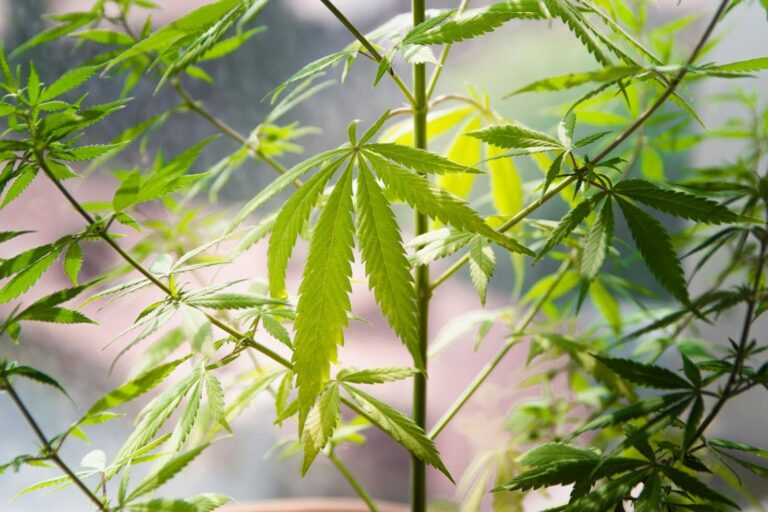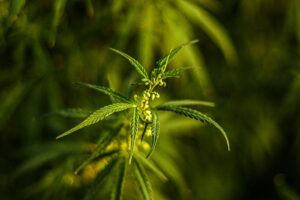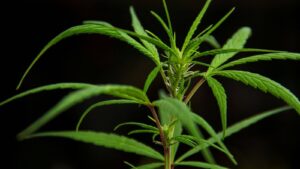Have you noticed yellowing edges on your cannabis leaves or weak, curling stems? These are signs of potassium deficiency, a common problem that can reduce yield and quality. Without enough potassium, your cannabis plants struggle to regulate water, transport nutrients, and build strong cell structures. Over time, this can lead to slow growth, weak stems, and smaller, less potent buds.
A lack of potassium affects plant structure and disrupts essential processes like enzyme activation and carbohydrate metabolism, which are crucial for plant energy production. When these functions break down, cannabis plants become more susceptible to disease, pest attacks, and environmental stress. Ensuring sufficient potassium levels helps plants maintain their strength and resilience throughout the growing cycle.
Understanding potassium deficiency helps you protect your plants and maximize your harvest. This guide covers why potassium is essential, how to identify and differentiate deficiency symptoms, the common causes behind it, and the best ways to treat and prevent the issue.
Understanding Potassium Deficiency in Cannabis
Potassium is one of the three primary macronutrients your cannabis plants need to thrive. It supports essential physiological processes and directly impacts growth, yield, and overall plant health. Without sufficient potassium, your plants struggle to perform key functions, leading to deficiencies that affect vegetative growth and flowering.
The Role of Potassium in Cannabis Growth
- Photosynthesis and Energy Production: Potassium helps regulate the opening and closing of stomata, which control gas exchange and water loss. This ensures efficient photosynthesis and energy conversion.
- Nutrient Transport and Metabolism: Potassium plays a role in moving water, carbohydrates, and other nutrients throughout the plant, ensuring healthy cell development.
- Stress Resistance and Disease Prevention: Potassium strengthens cell walls, making plants more resistant to pests, diseases, and environmental stressors.
- Terpene and Resin Production: This nutrient influences the production of terpenes, which impact the plant’s aroma, flavor, and potency. Higher potassium levels during flowering contribute to better-quality buds.
- Water Regulation and Drought Tolerance: Potassium helps cannabis plants regulate water retention, improving their ability to handle dry conditions and reducing the risk of wilting.
- Enzyme Activation and Protein Synthesis: This macronutrient is essential for activating enzymes that support protein synthesis, helping the plant grow strong and efficiently utilize other nutrients.
So, what are the causes of potassium deficiency in cannabis? Let us discuss this in detail.
Causes of Potassium Deficiency In Cannabis
Several factors can lead to a lack of potassium in your cannabis plants, and understanding them can help you prevent and address deficiencies effectively.
- Deficient Growing Medium: Some soils and hydroponic solutions may lack sufficient potassium, especially if they have not been amended with potassium-rich fertilizers.
- Improper pH Levels: If the pH is too high or too low, roots struggle to absorb potassium, even if it is present in the growing medium.
- Overwatering and Nutrient Leaching: Excess water can wash away essential nutrients, including potassium, making it less available to roots. Poor drainage and excessive irrigation further contribute to potassium loss.
- Nutrient Imbalances: High levels of calcium, nitrogen, or magnesium can interfere with potassium absorption, leading to deficiencies even when potassium is present.
- Depleted Soil Conditions: Reusing soil without proper amendment or relying on nutrient-deficient compost can result in inadequate potassium levels over time.
- Use of Low-Quality Fertilizers: Some fertilizers lack sufficient potassium or contain imbalanced N-P-K ratios that do not support healthy cannabis growth.
So, how do you identify potassium deficiency in your cannabis plant? Let us discuss.
Identifying Potassium Deficiency In Cannabis
Early detection is key to minimizing damage and ensuring your cannabis plants remain healthy throughout their growth cycle. Catching potassium deficiency early allows for quicker intervention and prevents irreversible damage to leaves, stems, and overall plant structure. Look for these signs:
- Yellowing or browning leaf edges: The discoloration usually starts at the tips and spreads along the margins. As the deficiency progresses, the affected areas may become dry and brittle, leading to cracking or further browning.
- Curling and twisting leaves: Affected leaves may appear distorted, with edges curling upwards or inwards. This deformation results from the plant’s inability to regulate water properly, causing irregular growth patterns.
- Leaf scorch and burnt appearance: Severe potassium deficiency leads to a scorched look, with dry, brown patches forming on leaves. This damage often resembles nutrient burn but primarily affects the leaf margins rather than the entire surface.
- Slow or stunted growth: Plants with potassium deficiency tend to grow more slowly and may appear weaker than their healthy counterparts. Internodal spacing may become irregular, leading to bushy yet fragile growth.
- Progression from yellowing to necrosis: If left untreated, affected areas of the leaves will turn from yellow to brown, eventually drying out and dying. This can lead to premature leaf drop, reducing the plant’s ability to photosynthesize efficiently.
- Brittle or weak stems: Potassium is essential for strong stem development. When deficient, stems may become thin, fragile, and prone to snapping, making it difficult for the plant to support its own weight, especially during flowering.
- Delayed flowering: Potassium plays a crucial role in bud formation. Plants may take longer to transition into the flowering stage when levels are too low, resulting in smaller and less potent buds at harvest.
- Increased susceptibility to pests and diseases: A lack of potassium weakens the plant’s immune system, making it more vulnerable to attacks from common cannabis pests like spider mites, aphids, and thrips. Fungal infections such as powdery mildew, may also become more prevalent in deficient plants.
Now, let us discuss some of the different possibilities that can indicate a potassium deficiency in your cannabis plant.
Differential Diagnosis
Potassium deficiency can mimic several other cannabis plant issues. Misdiagnosing the problem can lead to unnecessary treatments or worsen existing conditions. Before making adjustments, carefully assess your plants and rule out these possibilities:
- Light Burn: Excessive light exposure can cause symptoms that look similar to potassium deficiency, such as yellowing or browning at the edges of upper leaves. However, light burn usually affects only the topmost leaves closest to the light source, while potassium deficiency is more widespread.
- Nutrient Burn: Overfeeding your plants with high concentrations of nutrients, particularly synthetic fertilizers, can lead to nutrient burn. Unlike potassium deficiency, nutrient burn manifests as dark green leaves with burnt or crispy tips rather than uniform yellowing or browning along the edges.
- Nutrient Lockout: If your plants show stunted growth alongside widespread discoloration, it could be due to nutrient lockout. This occurs when an imbalance in soil pH or excessive nutrients prevents potassium from absorption, even if it is present in the growing medium.
- Magnesium or Calcium Deficiency: Magnesium deficiency often results in yellowing between leaf veins, while calcium deficiency leads to distorted growth and weak stems. These deficiencies can sometimes occur alongside potassium deficiency, making proper diagnosis essential.
- Overwatering Effects: Too much water can lead to nutrient leaching, washing away potassium before plants can absorb it. Poor drainage can also create an oxygen-deprived environment that hinders root function.
- Salt Buildup in Soil: Excess salts from synthetic fertilizers can interfere with potassium uptake, especially if there is an imbalance of sodium or other competing ions in the medium.
- Root Health Issues: Damaged or diseased roots struggle to absorb nutrients effectively. Root rot, soil compaction, or inadequate aeration can limit potassium availability, leading to symptoms that resemble deficiency.
To accurately diagnose potassium deficiency, examine your plant’s overall health, environmental conditions, and recent nutrient application. Testing soil or hydroponic solution pH can also help identify whether the issue stems from an absorption problem rather than a direct lack of potassium.
Tracking these factors over time makes prevention easier. PlanaCan helps you generate detailed harvest reports, tracking your cultivation decisions and their impact on yields. With all your data in one place, you can analyze trends, refine nutrient management, and optimize growing conditions for higher yields and better profitability.
Now, let us understand how your cannabis plants indicate potassium deficiency at different growth stages.
Potassium Deficiency in Different Cannabis Growth Stages
Deficiency at different stages affects plants in unique ways, impacting everything from structural integrity to final bud quality. Each growth phase presents its own challenges when potassium levels are too low, making it crucial to address deficiencies as early as possible.
- Vegetative Stage: Potassium deficiency at this stage can slow growth, delay node development, and weaken stem structure. However, since vegetative plants are still building their framework, deficiencies can be corrected more easily if addressed promptly.
- Pre-Flowering Stage: As plants prepare to transition into flowering, they require increased potassium for bud site development. A deficiency at this stage can lead to fewer flowering sites and a weaker structure to support buds.
- Flowering Stage: Potassium is essential for resin and terpene production, contributing to both potency and aroma. A deficiency can reduce bud size, lower trichome density, and compromise quality.
- Late-Flowering Stage: Severe potassium deficiency during the final weeks before harvest can reduce the final yield, cause premature leaf yellowing, and weaken the plant’s overall health, affecting bud density.
Here is a table that briefly shows how potassium deficiency affects different growth stages.
Growth Stage | Effects of Potassium Deficiency |
Vegetative Stage | Slows growth, delays node development, weakens stem structure. Easier to correct at this stage. |
Pre-Flowering Stage | Reduces bud site development and weakens support for future buds. |
Flowering Stage | Lowers resin and terpene production, decreases bud size and potency. |
Late-Flowering Stage | Causes premature leaf yellowing, reduces final yield, weakens bud density. |
Keeping an eye on potassium levels and adjusting nutrients helps prevent deficiencies, keeping your plants healthy and yielding high. PlanaCan tracks your cultivation decisions and their impact, organizing everything in one place. With easy access to past data, you can spot trends, refine your approach, and improve your results.
Now, let us understand how to ensure efficient potassium utilization and treat its deficiency in cannabis plants.
Ensuring Efficient Potassium Utilization & Treating Deficiency In Cannabis
To keep your cannabis plants healthy and thriving, you need to optimize potassium uptake and quickly address any deficiencies. Here’s how you can do that:
- Test and Monitor Nutrients: Regularly check your soil or hydroponic solution to prevent imbalances and ensure your plants have enough potassium.
- Choose the Right Fertilizers: Use fertilizers with the right N-P-K ratio for each growth stage. Organic options like wood ash, kelp meal, potassium sulfate, and composted banana peels can naturally boost potassium levels.
- Maintain Proper pH Levels: Keep the pH between 6.0-7.0 in soil and 5.5-6.5 in hydroponics to maximize potassium absorption.
- Balance Nutrients: Avoid overloading with nitrogen, calcium, or magnesium, as they can block potassium uptake.
- Improve Soil Quality: Ensure good aeration and drainage to prevent potassium from leaching away. Adding organic matter like worm castings or compost can help keep potassium readily available.
- Manage Watering Practices: Overwatering can wash away potassium, while underwatering restricts its movement to the roots. Water deeply but infrequently to maintain a consistent balance. PlanaCan helps you stay on top of watering schedules with a visual timeline for planning and tracking cultivation tasks. Organizing daily and long-term activities in one place ensures no task is overlooked, making it easier to adjust as plant needs change.
- Control the Growing Environment: Maintain stable humidity, temperature, and airflow to support efficient nutrient uptake. Introducing beneficial microbes into the soil can further enhance potassium absorption.
Conclusion
Potassium plays a critical role in cannabis cultivation. From strong vegetative growth to dense, resinous buds, its influence is undeniable. By managing potassium levels effectively, you ensure healthier plants and better harvests. Stay proactive with monitoring, proper fertilization, and environmental control to keep potassium deficiencies at bay and maximize your yields.
Managing nutrient schedules and cultivation tasks can be complex, but PlanaCan simplifies the process. It helps you define and automate every step of your cultivation, from planting to harvest, using customizable templates. This ensures consistency and efficiency in your growth cycles.
It also provides a clear visual timeline of your tasks. It helps you schedule work months in advance while allowing for real-time adjustments. The centralized system ensures that every step is accounted for, reducing errors and missed tasks.
By integrating PlanaCan into your workflow, you can streamline operations, improve plant health, and ultimately achieve higher yields. Schedule a free call today to learn how PlanaCan can help you manage your cannabis crops more effectively.




